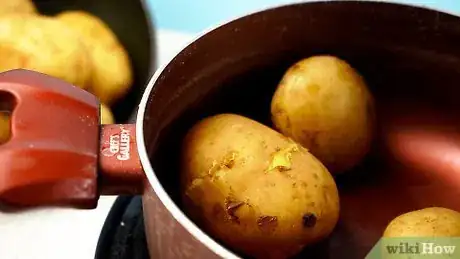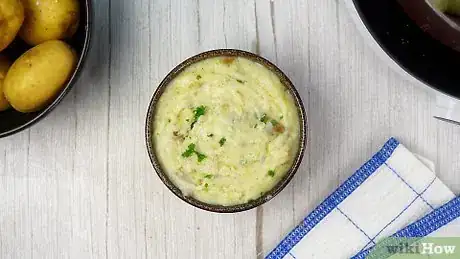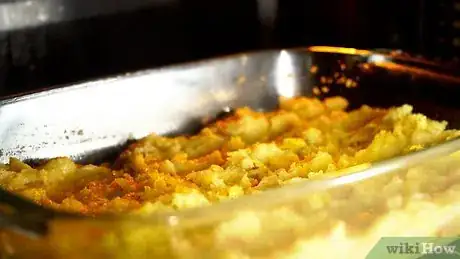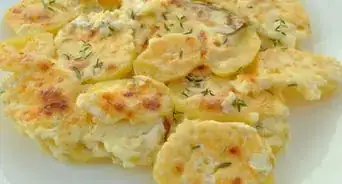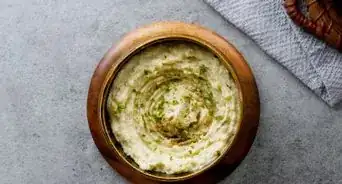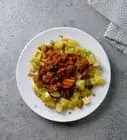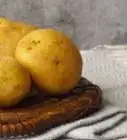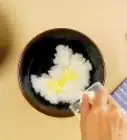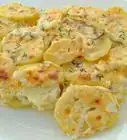This article was co-authored by wikiHow Staff. Our trained team of editors and researchers validate articles for accuracy and comprehensiveness. wikiHow's Content Management Team carefully monitors the work from our editorial staff to ensure that each article is backed by trusted research and meets our high quality standards.
The wikiHow Culinary Team also followed the article's instructions and verified that they work.
This article has been viewed 78,914 times.
Learn more...
Mashed potatoes are simple and easy to prepare. They make a great side dish to just about any dinner but go especially well with steak or turkey. You can make simple mashed potatoes using milk and butter or richer ones using sour cream. You can even make baked mashed potatoes for something extra special! Once you have the basics down, you can experiment with adding your own spices, herbs, and variations!
Ingredients
- 2½ pounds (1.2 kilograms) potatoes (Yukon gold or Russet)
- ½ cup (115 grams) unsalted butter
- 1 cup (240 milliliters) milk or half-and-half
- ½ tablespoon + 1 tsp salt, divided
- 3 pounds (1.4 kilograms) Yukon gold potatoes, peeled and cut
- 6 tablespoons (90 grams) unsalted butter, cut into pieces
- ¾ cup (190 grams) sour cream
- ¾ to 1 cup (180 to 240 milliliters) whole milk
- 1 teaspoon salt
- ½ teaspoon pepper
- 2½ pounds (1.2 kilograms) medium potatoes, peeled and cut
- 1 cup (250 grams) sour cream
- ¼ cup (60 milliliters) milk
- 2 tablespoons (30 grams) butter, melted
- 1½ cups (150 grams) shredded cheddar cheese, divided
- ½ cup (75 grams) chopped onion
- 5 bacon strips, cooked and crumbled
- ½ teaspoon salt
- ⅛ teaspoon pepper
Steps
Making Basic Mashed Potatoes
-
1Put the potatoes into a large pot of water. Do not peel or cut the potatoes. Instead, scrub them clean first, then put them into a large pot. Fill the pot enough water until the water level is 1 inch (2.54 centimeters) above the potatoes.
- Keeping the potatoes whole (not peeled or cut) will prevent them from absorbing too much water. It will also help preserve their flavor and texture.[4]
-
2Add ½ tablespoon of salt and boil the potatoes until they are well done. Depending on the size of the potatoes, this can take as little as 30 minutes to as long as 45 to 50 minutes. The potatoes are done if you can easily pierce them with a sharp knife or fork.Advertisement
-
3Drain the potatoes, then peel them if desired. You can leave the skins on if you wish, or you can peel them off. To do this, simply hold a potato in a potholder, then use a paring knife to pull the skin off; it should peel off easily.[5]
-
4Heat the butter and milk separately. Heat the butter in one saucepan, and the milk in another. For extra flavor, add the remaining salt to the milk. You will be adding the butter first, then the milk. This will help improve the texture of the potatoes.
-
5Mash the potatoes. You can do this using a potato masher directly in the pot you cooked them in. This will also help keep them warm and you won't have to clean as many dishes. If you find mashing them difficult, cut them into smaller pieces using a knife first.
-
6Stir the butter into the potatoes using a rubber spatula or a wooden spoon. Keep stirring until the butter is mixed evenly throughout. Over time, it will get absorbed into the potatoes. When that happens, you are ready for the milk.
-
7Add the milk after the butter is absorbed and stir. The potatoes will appear liquidy at first, but they will eventually soak in the milk. If you are concerned about this, however, you can pour in the milk a little bit at a time, and add more after the potatoes have finished absorbing it.
-
8Taste the potatoes and make any adjustments if desired. At this point, you can add extra salt, pepper, and butter. For extra flavor, add 1 tablespoon of any of the following: chopped chives, fresh dill, garlic, paprika, fresh chopped parsley, fresh rosemary, or fresh thyme.[6] [7] If you choose to use dried dill, rosemary, or thyme, reduce the amount to 1 teaspoon; taste, and add more if needed.
-
9Serve the potatoes. Transfer them to a serving dish, and serve them while they are still hot. If you have any leftovers, cover them, and store them in the fridge.
Making Sour Cream Mashed Potatoes
-
1Peel and cut the potatoes, then put them into a large pot of water. Peel the potatoes first, then cut them into 1-inch (2.54 centimeters) cubes; this will help them cook faster. Cover the potatoes with water; make sure they are completely submerged.
-
2Add 2 teaspoons of salt, then cook the potatoes until they are tender, about 20 to 25 minutes. Bring the water to a boil first, then reduce the heat to a simmer. Cook the potatoes until they are soft and easily pierced with a fork.
-
3Drain the potatoes and leave them in the pot. This will help dry the potatoes and keep them warm.
-
4Mash the potatoes using a potato masher. Don't worry about getting them perfectly smooth just yet. You will be adding butter, milk, and sour cream later on, which will help make them smoother.
-
5Add the butter, sour cream, salt, pepper, and ¾ cup (180 milliliters) of the milk.[8] Stir them in using a rubber spatula or a wooden spoon. Don't add in all of the milk just yet; you may not need it. The potatoes may appear too thin at first, but they will thicken up once they soak up the milk and butter.
- If the mashed potatoes don't seem thick enough for your liking, read How to Thicken Mashed Potatoes.
-
6Taste the potatoes and make any necessary adjustments. At this point, you can add some more salt, pepper, or milk. You can also add 1 tablespoon of fresh herbs, such as chopped chives, or 1 teaspoon of dried herbs, such as dill.
-
7Serve the potatoes. They taste great on their own or with some extra butter. Cover and refrigerate any leftovers.
Making Baked Mashed Potatoes
-
1Preheat the oven to 350°F (177°C).
-
2Boil the potatoes until they are tender, then drain them. Peel and cut the potatoes into 1-inch (2.54 centimeters) cubes first, then put them into a large pot of water; the water should cover completely cover the potatoes. Cook the potatoes until they are done, about 15 to 20 minutes, then drain them.
-
3Mash the potatoes. Put the potatoes back into the pot, and mash them with a potato masher. Don't worry about making them perfectly smooth just yet; they will become smoother once you add the milk and sour cream.
-
4Add the sour cream, milk, butter, and 1 cup (100 grams) of shredded cheese. Continue mashing the potatoes until everything is evenly combined. Once the potatoes are soft, you can stir them with a rubber spatula or wooden spoon. The potatoes may look soupy at first, but they will eventually soak up the liquid and thicken up. Save the remaining ½ cup (50 grams) of cheese for later.[9]
-
5Add the onion, bacon, salt, and pepper, and stir again. You can cook your own bacon beforehand, or you can use the pre-cooked, crumbled kind that comes from a package. Stir the potatoes until everything is evenly combined and distributed.
-
6Scoop the potatoes into a greased, 2-quart (2 liters) casserole dish and cover them with the remaining shredded cheese. Smooth the potatoes down first with a spatula; any peaks that are sticking up may get burned. Next, sprinkle the rest of the cheese over them. Do not stir the cheese in.
-
7Bake the potatoes for 30 to 35 minutes. The potatoes are ready when the cheese is melted and the potatoes are heated through.
-
8Serve the potatoes. Let the potatoes cool a little first, then serve them while they are still hot. Cover and refrigerate any leftovers.
Community Q&A
Did you know you can get answers researched by wikiHow Staff?
Unlock staff-researched answers by supporting wikiHow
-
QuestionCan I make mashed potatoes in a food processor?
 wikiHow Staff EditorThis answer was written by one of our trained team of researchers who validated it for accuracy and comprehensiveness.
wikiHow Staff EditorThis answer was written by one of our trained team of researchers who validated it for accuracy and comprehensiveness.
Staff Answer wikiHow Staff EditorStaff Answer
wikiHow Staff EditorStaff Answer -
QuestionWhat can I add to mashed potatoes to make them more interesting?
 wikiHow Staff EditorThis answer was written by one of our trained team of researchers who validated it for accuracy and comprehensiveness.
wikiHow Staff EditorThis answer was written by one of our trained team of researchers who validated it for accuracy and comprehensiveness.
Staff Answer wikiHow Staff EditorStaff AnswerSome good things to add to your mashed potatoes include: Crushed roasted garlic, roasted bell pepper pieces, pepper, Parmesan cheese flakes (or other strong cheese you like), chopped chives or scallions, flavored oil or truffle oil, cream cheese/sour cream/buttermilk, fresh herbs (chopped), chili powder, saffron, pesto, roasted garlic, creamed corn, etc.
wikiHow Staff EditorStaff AnswerSome good things to add to your mashed potatoes include: Crushed roasted garlic, roasted bell pepper pieces, pepper, Parmesan cheese flakes (or other strong cheese you like), chopped chives or scallions, flavored oil or truffle oil, cream cheese/sour cream/buttermilk, fresh herbs (chopped), chili powder, saffron, pesto, roasted garlic, creamed corn, etc. -
QuestionWhat type of potato should I use for mashed potatoes?
 wikiHow Staff EditorThis answer was written by one of our trained team of researchers who validated it for accuracy and comprehensiveness.
wikiHow Staff EditorThis answer was written by one of our trained team of researchers who validated it for accuracy and comprehensiveness.
Staff Answer wikiHow Staff EditorStaff AnswerThe best potatoes for mashing are known as "floury" potatoes; look for potatoes that produce creaminess and have moderate levels of starch. This includes varieties such as: Sebago, Yukon Gold, Russet/Idaho, Kennebec, Spunta, Pontiac, Dutch yellow and Coliban. It's worth trying other varieties too, as you never know which work best in your part of the world until you've tried them. If you use a variety that doesn't cream very well, fix it with the addition of cream cheese, cheese, sour cream or buttermilk, and it'll be a lot nicer.
wikiHow Staff EditorStaff AnswerThe best potatoes for mashing are known as "floury" potatoes; look for potatoes that produce creaminess and have moderate levels of starch. This includes varieties such as: Sebago, Yukon Gold, Russet/Idaho, Kennebec, Spunta, Pontiac, Dutch yellow and Coliban. It's worth trying other varieties too, as you never know which work best in your part of the world until you've tried them. If you use a variety that doesn't cream very well, fix it with the addition of cream cheese, cheese, sour cream or buttermilk, and it'll be a lot nicer.
Warnings
- Be careful of boiling hot water when draining your potatoes.⧼thumbs_response⧽
Things You'll Need
Basic Mashed Potatoes
- Large pot
- Potato masher
- Two small saucepans
- Spatula or wooden spoon
Sour Cream Mashed Potatoes
- Large pot
- Potato masher
- Spatula or wooden spoon
Baked Mashed Potatoes
- Large pot
- Potato masher
- 2-quart (2 liters) casserole dish
- Spatula or wooden spoon
References
- ↑ http://www.thekitchn.com/how-to-make-mashed-potatoes-for-a-crowd-cooking-lessons-from-the-kitchn-180434
- ↑ http://www.realsimple.com/food-recipes/browse-all-recipes/sour-cream-mashed-potatoes-0
- ↑ http://www.tasteofhome.com/recipes/double-baked-mashed-potatoes
- ↑ http://www.thekitchn.com/how-to-make-mashed-potatoes-for-a-crowd-cooking-lessons-from-the-kitchn-180434
- ↑ http://www.thekitchn.com/how-to-make-mashed-potatoes-for-a-crowd-cooking-lessons-from-the-kitchn-180434
- ↑ http://www.williams-sonoma.com/recipe/garlic-mashed-potatoes.html
- ↑ http://www.bettycrocker.com/recipes/silky-garlic-mashed-potatoes/15d518df-38a7-48fa-a878-764c54cd1832
- ↑ http://www.realsimple.com/food-recipes/browse-all-recipes/sour-cream-mashed-potatoes-0
- ↑ http://www.tasteofhome.com/recipes/double-baked-mashed-potatoes

